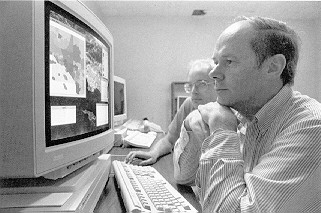Preventing environmental damage, protecting human health, and improving ecological
sustainability are major motivations for much of the present research worldwide
on energy technology. If not properly controlled, emissions from energy-related
activities may create pollution problems on local, regional, and global scales.
Energy Laboratory research on Environmental and Health Effects seeks to understand
how pollutants are formed, transported, and modified in the environment, and which
energy by-products are truly harmful to people and therefore deserving of technological
and policy countermeasures. The health effects research is carried out in close
collaboration with the MIT Center
for Environmental Health Sciences, which is directed by Professor William
Thilly. The Energy Laboratory also actively participates in the Program
for Environmental Engineering Education and Research and the multi-university
Alliance for Global Sustainability,
both of which are directed by Professor David Marks.
Current research relating to air quality focuses on the human and environmental
health impacts of gaseous, liquid, and solid airborne emissions from energy
production, conversion, and utilization. Anchoring those endeavors is the Center
on Airborne Organics, a collaborative effort between MIT, the California
Institute of Technology, and the New Jersey
Institute of Technology that is directed by Professor
Jack Howard and funded by the US Environmental
Protection Agency (EPA). The overall goal of the center is to provide EPA
with the tools--improved methodologies and predictive and interpretive models--to
connect the identities and concentrations of airborne organic compounds with
major pollutant emission sources arising from human activity. A key feature
of the center's research program is to develop a mechanistic understanding of
the factors that govern the detailed chemical compositions of the effluents
from mobile and stationary combustion systems and to determine how pollutant
compositions change as emissions products move through the atmosphere. Also
examined are how pollutants migrate in the air and how they ultimately affect
local, regional, and global environments. In addition, research seeks to define
the mechanisms that lead to the formation of specific toxicants and to understand
how pollutants and their transformation products degrade human health. The results
of these studies will clarify how specific chemical or physical attributes of
pollutants can be used to trace their origins. This information will help identify
technological and policy strategies that will reduce or eliminate specific emissions
that are, or will become, hazardous.

Gregory J. McRae
Other research focuses on the fate and transport of toxic chemicals in groundwater and soils. One project is demonstrating a new method for detecting groundwater contamination and identifying the source of the pollution. The method involves analyzing patterns of concentrations of trace elements that can be linked to specific pollution sources. Other field studies are developing improved instrumentation for in-situ measurement of volatile organic compounds in groundwater. Additional research is exploring the role of colloid-sized particles and macromolecules in transporting hydrophobic organic compounds--for example, polychlorinated biphenyls and polycyclic aromatic compounds--and trace metals in groundwater.
Selected Participants
- E. Eric Adams, Civil and Environmental Engineering: environmental fluid mechanics; marine pollution.
- Janos M. Beér, Chemical Engineering: industrial flames; emissions control.
- Philip M. Gschwend, Civil and Environmental Engineering: organic chemistry;
marine and groundwater pollution.
- Harold F. Hemond, Civil and Environmental Engineering: watershed chemistry;
field instrumentation; groundwater contamination.
- John B. Heywood, Mechanical Engineering: automotive emissions.
- Simone Hochgreb, Mechanical Engineering: automotive emissions.
- Jack B. Howard, Chemical Engineering: combustion emissions; formation of
soot and polycyclic aromatic compounds.
- Arthur L. Lafleur, Center for Environmental Health Sciences: analytical chemistry; complex organic mixtures.
- John P. Longwell, Chemical Engineering: automotive emissions; combustion science and engineering.
- David H. Marks, Civil and Environmental Engineering and Program for Environmental
Engineering Education and Research: water quality management; mathematical
optimization; water resource systems.
- Dennis McLaughlin, Civil and Environmental Engineering: groundwater hydrology; design of environmental monitoring systems.
- Gregory J. McRae, Chemical Engineering: air models; industrial ecology;
environmental policy.
- Ilhan Olmez, Nuclear Reactor Laboratory: trace elements in environmental research.
- William A. Peters, Energy Laboratory: health effects of combustion emissions; thermal chemical technologies for environmental remediation, soil cleanup, and hazardous waste destruction.
- Adel F. Sarofim, Chemical Engineering: combustion and emissions control;
air quality; thermal destruction of waste.
- Kenneth A. Smith, Chemical Engineering: fluid mechanics; environmental remediation
technologies.
- William G. Thilly, Center for Environmental Health Sciences: toxicology.
- Victor W. Wong, Energy Laboratory: automotive emissions.
The Center on Airborne Organics,
headquartered at MIT, founded by Professor Adel Sarofim, and directed by Professor
Jack Howard, is one of four exploratory environmental research centers funded
nationwide by the US Environmental Protection Agency. Its research focuses on
sources, atmospheric transformation, monitoring, and control of organic pollutants
in ambient air. To gather a strong group of experts to address these issues, the
center operates as a consortium of MIT, the California
Institute of Technology (Caltech), and the New
Jersey Institute of Technology (NJIT). Professor John Seinfeld (Caltech) and
Professor Richard Magee (NJIT) are associate directors. Energy production, conversion,
and utilization are major potential sources of air pollution; and energy technologists
and policymakers are often the sources of new ideas for controlling or eliminating
toxic anthropogenic emissions. Therefore, the Energy Laboratory plays a major
role in hosting this center at MIT, in collaboration with the center's co-host,
the MIT Center for Environmental
Health Sciences.
MIT projects have included examination of fundamental chemical and physical processes of pollutant formation in automotive engines, research on the chemistry of the formation and transformation of polycyclic organic compounds in flames, fundamental studies of the detailed physical structure of soot to develop new methods for identifying emissions sources and formation processes, and fundamental studies of the effects of retrofitted burners on pollutant emissions from industrial flames.
Back to Current Research
Areas or
 the Energy
Laboratory Home Page.
the Energy
Laboratory Home Page.



 the Energy
Laboratory Home Page.
the Energy
Laboratory Home Page.